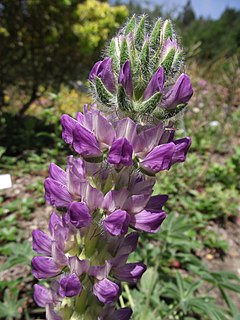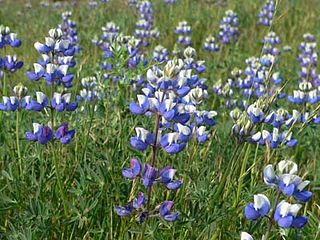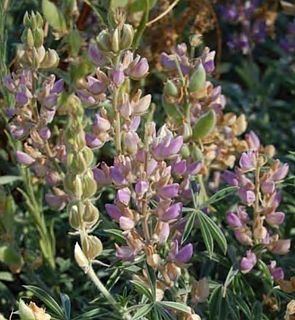
Lupinus polyphyllus is a species of lupine (lupin) native to western North America from southern Alaska and British Columbia east to Quebec, and western Wyoming, and south to Utah and California. It commonly grows along streams and creeks, preferring moist habitats.

Lupinus, commonly known as lupin or lupine, is a genus of flowering plants in the legume family, Fabaceae. The genus includes over 200 species, with centers of diversity in North and South America. Smaller centers occur in North Africa and the Mediterranean. They are widely cultivated, both as a food source and as ornamental plants.

Lupinus arboreus, common name yellow bush lupine (US) or tree lupin (UK), is a species of flowering plant in the legume family Fabaceae.

Eriophyllum lanatum, with the common names common woolly sunflower and Oregon sunshine, is a common, widespread, North American plant in the sunflower family.

Lupinus sulphureus is a species of lupine, a flowering plant of the legume family, Fabaceae. It is native to western North America from southern British Columbia south through Washington to Oregon. It is a perennial herbaceous plant growing to 40 to 80 cm tall. The leaves are palmately compound, with 7 to 13 leaflets each 2 to 5 cm long. The flowers are produced in whorls on a spike 12 to 20 cm long.

Lupinus microcarpus, the wide-bannered lupine or chick lupine, is a species of lupine native to western North America from southwestern British Columbia south through Oregon and California, including the Mojave Desert, and into Baja California. There is also a disjunct population in South America, with locations in central Chile and western Argentina.

Lupinus texensis, the Texas bluebonnet or Texas lupine is a species of lupine endemic to Texas, plus the Mexican states of Coahuila, Nuevo León, and Tamaulipas. With other related species of lupines also called bluebonnets, it is the state flower of Texas.

Lupinus nanus, is a species of lupine native to the western United States. It is found natively in California, Nevada, and on Steens Mountain in eastern Oregon. It tends to be found growing on slopes and in open or disturbed areas below 1300 meters. It grows 6 to 20 inches tall with blue flowers containing white or yellow spots. It is an annual plant that blooms in the months of March, April and May. It contains anagyrine and is considered toxic if directly ingested. Among the biologically active chemicals found in the pant are genistein, 2'-hydroxygenistein, luteone and wighteone.
Lupinus latifolius var. barbatus, the Klamath lupine, sometimes also called bearded lupine, is a very rare plant of the Western U.S., known only from northeastern California and southeastern Oregon. It is a rare variety of the generally common species L. latifolius, which is a member of the bean family.

Lupinus bicolor is a species of lupine known as the miniature lupine, Lindley's annual lupine, pigmy-leaved lupine, or bicolor lupine.

Lupinus excubitus is a species of lupine known as the grape soda lupine. Its common name refers to its sweet scent, which is said to be very reminiscent of grape soda. This species and its variants are found in Southwestern United States, especially in California and Nevada, e.g., Death Valley and Joshua Tree National Parks, and northwestern Mexico.

Lupinus nootkatensis, the Nootka lupine, is a perennial plant of the genus Lupinus in the legume family, Fabaceae. It is native to North America. The Nootka lupine grows to 60 cm tall. Late in the 18th century it was first introduced to Europe.

Lupinus albifrons, silver lupine, white-leaf bush lupine, or evergreen lupine, is a species of lupine (lupin). It is native to California and Oregon, where it grows along the coast and in dry and open meadows, prairies and forest clearings. It is a member of several plant communities, including coastal sage scrub, chaparral, northern coastal scrub, foothill woodland, and yellow pine forest.

Lupinus formosus, the summer lupine or western lupine, is a species of flowering plant in the legume family, Fabaceae. It is native to California and Oregon in the United States.

Lupinus sericeus is a species of flowering plant in the legume family known by the common name silky lupine or Pursh's silky lupine. It is native to western North America from British Columbia to Arizona and east to Alberta and Colorado.

Lupinus arcticus is a species of flowering plant in the legume family known by the common names Arctic lupine or subalpine lupine. It is native to northwestern North America, where it occurs from Oregon north to Alaska and east to Nunavut. It is a common wildflower in British Columbia.

Lupinus lepidus, the Pacific lupine, prairie lupine or dwarf lupine is a perennial herbaceous plant in the pea family (Fabaceae) endemic to western North America.
Erigeron pumilus is a hairy North American species of perennial plants in the. It is widespread across much of western Canada and the western United States, from British Columbia east to Saskatchewan and south as far as Oklahoma and the San Bernardino Mountains of California. There have been reports of the plant growing in Yukon Territory, but these were based on misidentified specimens.

Lupinus pusillus, the rusty lupine or dwarf lupine, is an annual plant in the legume family (fabaceae) found in the Colorado Plateau and Canyonlands region of the southwestern United States, and north to Montana.

Wilhelm Nikolaus Suksdorf was a German–American botanist, who specialized in the flora of the Pacific Northwest. He was largely self-taught and is considered one of the top three self-taught botanists of his era for the Pacific Northwest; the other two being Thomas Jefferson Howell and William Conklin Cusick.




















